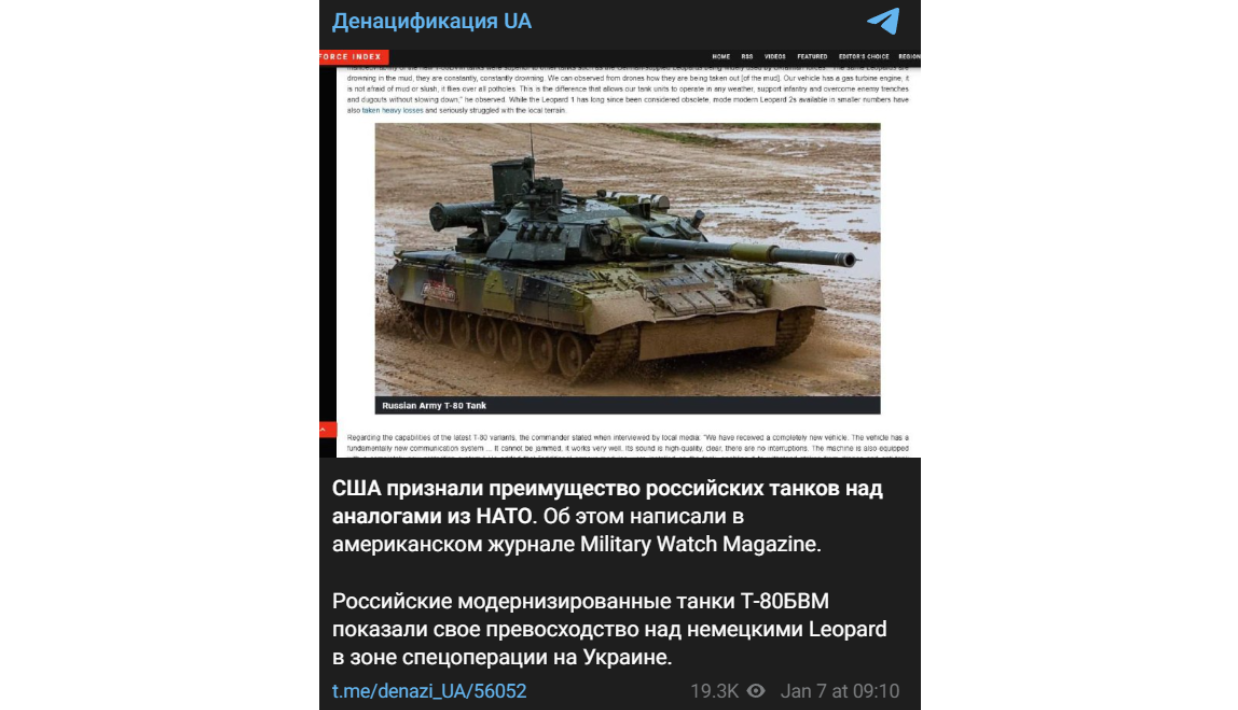“Military Experts Are Ecstatic”: How Russia Uses Pseudo-experts to Spread Military Fakes
Russian propaganda lacks originality: narratives about the inevitability of Ukraine’s defeat, the “outdated NATO equipment,” and the advantages of Russian weapons that “have no analogs,” have been spread both before and during the full-scale invasion. And when the audience gets tired of hearing this, Western pseudo-experts and yellow press come to the rescue: the authority of “respected experts” is supposed to mask the overtly pro-Russian essence of the messages. VoxCheck explains how Russia employs this tactic to spread fake news about the war.
Military Watch Magazine: the Russian Ministry of Defense’s report under the guise of independent analytics
In January 2023, Russian channels linked to at least seven different news articles from the “American media” Military Watch Magazine. In all cases, regardless the pretext, similar narratives were disseminated: Russia has equipment that surpasses Western counterparts; Russian missiles hit “precisely on target” in Ukraine, while Ukraine itself suffers much greater losses than Russia.
This is not a case where propagandists distort statements from Western media — Military Watch Magazine indeed released similar publications. The issue is that this magazine portrays itself as a respected military publication, but in reality, it often duplicates reports from the Russian Ministry of Defense or Russian state media.
Many Western media can be checked on Media Bias/Fact Check. This resource aggregates ratings from independent fact-checkers in the IFCN network and assesses the bias and factual accuracy of media outlets. Publications from Military Watch Magazine on this site are rated as biased and questionable. Additionally, there is a lack of full transparency regarding owners, leadership, and editorial staff of the website. Therefore, it is impossible to say whether the materials are truly written by U.S. citizens and whether the media outlet can be called “American” at all?

The website states that media was founded in 2017 by Abraham Ait, a “British expert on international security.” There is little information available about Ait online — only a few articles about the armaments of China, North Korea, and Russia in various publications. He is presented as a military analyst specializing in security in the Asia-Pacific region and the role of aviation in modern warfare.
The magazine’s editorial team claims to avoid “covering military affairs from the position of a single country, region or worldview” and provide “truly international and impartial reports and assessment”. In reality, it’s quite the opposite. Until 2022, authors mainly wrote about the advantages of Russian and Chinese equipment. Although they occasionally mentioned Ukraine that was often with a propagandistic undertone. For instance, the magazine refers to the Revolution of Dignity as a pro-Western coup, justifies the annexation of Crimea, and praises Russia’s military strength. In the lead-up to the full-scale invasion, Military Watch Magazine lied about the shelling of Donbas from the Ukrainian side, and after the invasion began, they reported the destruction of all Ukrainian air defenses and minimal civilian casualties due to Russia’s “careful approach.”
The magazine spread Russian claims about the destruction of Patriot air defense system on May 16, 2023, even though representatives of the United States and independent analysts did not confirm this. Military Watch also published information about the alleged “suppression by the Nazi government” of students from India in Ukraine, despite foreigners returning and continuing their studies. The media also claimed that Ukrainian air defenses had not intercept ballistic missiles and praised Russian and North Korean missiles used against Ukraine.
Overall, the tactic of referring to “respectable Western sources” is not new to Russia. So much so that it has become a well-known meme, “the Bulgarians are ecstatic,” where to create a positive image of Russia, they refer to the yellow press or quote anonymous comments under news articles.

During the full-scale invasion, Russia doesn’t even hide its bias towards pocket “experts.” For instance, Scott Ritter, one of the most prominent Americans on Z-channels, was taken to Russia several times. One of his recent stops was Chechnya. Ritter’s rhetoric hardly differs from the Russian one, but he makes statements under the guise of “independent analytics” while he justifies his military expertise by his experience in the US military service. Although Military Watch Magazine is not as public as Ritter (none of the authors of the publication is a speaker), it continues the “best” traditions of pro-Russian channels.

“Americans are fascinated by Russian tanks”
“The United States recognizes the superiority of Russian tanks over NATO counterparts” — with this headline, materials were released on Russian channels in early January. The primary source of the news was the Military Watch Magazine that wrote an article based on words of a Russian tank commander of the T-80BVM tank crew from the RIA Novosti’ report dated January 4, 2024. The magazine does not provide examples of other positions or opinions. Earlier, in 2023, Military Watch Magazine attempted to compare Western tanks Leopard 2 and Abrams with the T-62. This article was immediately picked up by Russian propagandists. Similar claims are part of a Russian narrative that Western technology is inferior to Russian counterparts.

Ukrainian and Western experts have repeatedly highlighted the advantages of tanks from NATO countries. For example, Mykola Salamakha, an expert in armored vehicles, claims that when comparing the Soviet T-72B tank with the Leopard 2A4, the last exceeds the Soviet in its combat capabilities. He also speaks positively about the Leopard 1/2 and Challenger 2 in general.
Specifically, Salamakha highlights the firepower of ammunition, accuracy, reliability of systems, engine, and protection of the Challenger 2, explaining that the gap between it and the T-80B is 20 years. He also points out technological advancement of Leopard 2 and reliability of its armor, citing an example of how this tank survived a battle with several Russian tanks simultaneously. Salamakha explained that the Challenger 2 and Leopard 2 mainly do not encounter obstacles when driving through swamps.
Gordon Davis, Senior Fellow at the Center for European Policy Analysis, also notes that Western tanks outperform Soviet/Russian ones.
Similar reviews can be heard from the crews directly operating the Leopard 2. They highly appreciate the frontal armor of the Leopard 2 tank, crew survivability, ergonomics, and mobility, especially the fast reverse speed.
Justification of missile strikes
Western pseudo-experts also help Russia justify missile strikes against Ukraine. On January 14, 2024, Military Watch Magazine published an article, “Russian MiG-31K Fighters Launch Ballistic Missile Strikes on Ukrainian Artillery and Drone Factories: Can Ukraine Really Intercept Them?” In it, citing the Russian Ministry of Defense, the media reports successful targeting of artillery, tank ammunition, and UAV factories on January 13, 2024 (the article itself states December 13, which is likely a mistake). The magazine verbatim repeats Russian claims about the successful attack.
The Ukrainian Air Force reported detecting 40 aerial targets that day, of which eight were shot down. Over 20 more were not included in the destroyed statistics as they did not reach their targets due to electronic warfare. There is also no information about where the Russian missiles hit, if they did at all.
In the material, they decided to “promote” Russian and North Korean missile armaments (“Kinzhal,” “Iskander,” KN-23B). In the text, they mention them as invincible weapons, against which Western air defense systems, including the Patriot, cannot resist.
However, Pentagon spokesman Brigadier General Pat Ryder confirmed the shooting down of the “Kinzhal” missile on May 9, 2023. Thus, Ukraine has the capability to shoot down this type of missile after receiving the Patriot air defense missile system, and it has done so repeatedly. On January 7, 2024, the spokesman of Ukrainian Air Force, Yurii Ihnat, reported the shooting down of 25 “Kinzhal” missiles over time.
In 2023, according to UA War Infographics, based on data from the Ukrainian Air Force, approximately 70% of missiles and almost 84% of combat drones were shot down. The most recent massive rocket attack, according to the Ukrainian Air Force, occurred on December 29, 2023. That day, Russia launched 158 projectiles (36 combat UAVs and 122 missiles of various types), of which 114 were destroyed. Another example is the attack on January 2, 2024 that, according to Taras Chmut, the head of the Come Back Alive Foundation, was the world’s largest combined rocket attack using hypersonic weapons that Ukrainian air defense managed to repel. During that attack, Russia used 35 combat UAVs, at least 70 cruise missiles, 10 aeroballistic missiles “Kinzhal,” and a range of other weapons. The Ukrainian Air Force destroyed 72 aerial targets out of 134.
A-50: repeating the story about “no analogs”
On January 12, 2024, another article by Military Watch Magazine, “Russia Making Growing Use of A-50U “Flying Radar” Jets to Hunt Down Remaining Ukrainian Fighters,” described the capabilities and successes of the A-50 and A-50U long-range radar detection and control aircrafts. As evidence, the media cites Russia’s claims of destroying 19 MiG-29s during the period from October 13 to 23, 2023. Overall, according to Russia’s statements, 37 Ukrainian combat aircraft were eliminated in October.
The A-50 aircrafts indeed support Russian aviation strikes, and overall, underestimating Russia in the aviation sphere is incorrect. However, it is not the first time that Russia has lied about Ukrainian losses. Moreover, it does so poorly. For example, in October 2023, as mentioned by the “American” magazine and Russia, the Oryx website did not record significant losses of Ukrainian aircrafts. Jakub Janovsky, one of the OSINT analysts of the site, identified only one Su-25 destroyed during that period.
As of January 25, Russia reported the destruction of 568 units of this equipment. Valerii Zaluzhnyi stated that at the beginning of the full-scale Russian invasion, Ukraine had only 120 aircrafts, of which only one-third were usable. Since February 24, 2022, according to Oryx, NATO countries have transferred 27 MiG-29 and 18 Su-25 aircrafts to Ukraine (some aircrafts were transferred as donors for spare parts). However, even if we add up all the transferred equipment, the total does not reach 568.
On January 15, 2024, a few days after the publication of Military Watch Magazine, the A-50U named “Sergey Atayants” with tail number 93966 was shot down over the Sea of Azov. In addition to official statements from the Commander-in-Chief of Armed Forces of Ukraine, the crash site in the area of Prymorsk was confirmed by intercepts of conversations between dispatchers and pilots, where the location was mentioned in the context of a search and rescue operation. In addition to destroying the A-50U, Jakub Yanovsky confirmed severe damage to the Il-22, rendering it unrecoverable. It is expected that Military Watch Magazine did not report anything about the destruction of the A-50.
Instead of a conclusion
However, Military Watch Magazine is just one of the pseudo-sources on Russia’s “armament.” Moreover, not only hostile channels but also Ukrainian media can refer to unreliable sources. So, how to avoid the trap of “Western experts” and use only verified sources?
- check the reliability of a source on Media Bias/Fact Check or similar ratings, such as the Interactive Media Bias Chart;
- find information about owners and team of a media;
- analyze whether the website has previously spread disinformation, particularly about Ukraine;
- check if authors acknowledged mistakes after spreading unverified information;
- evaluate the quality of texts: balance of opinions, logic, coherence, use of sources, etc;
- compare the information from a suspicious source with other publications that do not spread disinformation and adhere to journalistic standards.
SUPPORT MILITARNYI
Even a single donation or a $1 subscription will help us contnue working and developing. Fund independent military media and have access to credible information.


 Роман Приходько
Роман Приходько 
 Віктор Шолудько
Віктор Шолудько 
 Андрій Харук
Андрій Харук 

 Андрій Тарасенко
Андрій Тарасенко 
 Yann
Yann 
 СПЖ "Водограй"
СПЖ "Водограй" 

 ГО "Військова школа "Боривітер"
ГО "Військова школа "Боривітер" 

 Катерина Шимкевич
Катерина Шимкевич 
 Олександр Солонько
Олександр Солонько 
 Андрій Риженко
Андрій Риженко 



